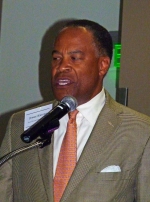UTILITY ALSO PRESENTS ITS ENERGY RESOURCE PLAN FOR OUR REGION AT ECEDC COMMUNITY LEADERS SPOTLIGHT
 May 25, 2010 (San Diego’s East County) – San Diego Gas & Electric (SDG&E) has announced that the company will bring the world’s largest heavy-lifting helicopter in the world to our region to construct Sunrise Powerlink, which SDG&E hopes to begin constructing this summer. “It can also be used for firefighting—and it can bring up to 2,500 gallons of water,” said Michael R. Niggli, president and chief operating officer of SDG&E. By contrast, the largest firefighting helicopter previously in San Diego had a capacity of 300 gallons, he said.
May 25, 2010 (San Diego’s East County) – San Diego Gas & Electric (SDG&E) has announced that the company will bring the world’s largest heavy-lifting helicopter in the world to our region to construct Sunrise Powerlink, which SDG&E hopes to begin constructing this summer. “It can also be used for firefighting—and it can bring up to 2,500 gallons of water,” said Michael R. Niggli, president and chief operating officer of SDG&E. By contrast, the largest firefighting helicopter previously in San Diego had a capacity of 300 gallons, he said.
Niggli made the remarks during the East County Economic Development Council’s Community Leaders Spotlight at Cuyamaca College in Rancho San Diego yesterday. The company's executives also presented business and education leaders with its plans for economic revitalization and sustainable energy that SDG&E indicated will benefit East County.
The $30 million helicopter is being built in Oregon and is anticipated to arrive here mid-summer, Niggli told East County Magazine. Pilots are trained for precision dropping to target power line fires but will also be available to assist in fighting wildfires on request throughout our region to battle fires unrelated to power lines, he said. SDG&E will also have a wildfire strike team to assist its crews.
Asked if the helicopter would remain after Powerlink Construction is completed (assuming the project is built; Powerlink still faces court challenges and is awaiting approval from the U.S. Forest Service) , Niggli said he would like to see the helicopter remain here if resources were available to pay for it.
 Also at the event, SDG&E’s new chairman and CEO, Jessie Knight Jr., out lined plans for “being a utility of the future.” He said the San Diego region will be in the forefront of a “revolution” to include technology such as smart grid and sustainable energy sources. He also pledged greater transparency under his leadership. “Don’t be afraid to ask the tough questions,” he said, adding that the company is “serious about economic development” for East County.
Also at the event, SDG&E’s new chairman and CEO, Jessie Knight Jr., out lined plans for “being a utility of the future.” He said the San Diego region will be in the forefront of a “revolution” to include technology such as smart grid and sustainable energy sources. He also pledged greater transparency under his leadership. “Don’t be afraid to ask the tough questions,” he said, adding that the company is “serious about economic development” for East County.
Niggli noted that Knight had a lesson in emergency response on his first day on the job—when a 7.2 earthquake struck in Mexico, damaging utility infrastructure in Imperial Valley.
Niggli credited AB 32 with “driving a lot of what we are doing for the future” to transition to renewable energy sources including wind, solar and biofuels as well as energy conservation.
 He said SDG&E is installing 5,000 to 7,000 smart meters daily into the market, which enables the utility to read bills online and tell instantly if power is lost to a home or business. Consumers will soon be able to view their information online as well, he noted.
He said SDG&E is installing 5,000 to 7,000 smart meters daily into the market, which enables the utility to read bills online and tell instantly if power is lost to a home or business. Consumers will soon be able to view their information online as well, he noted.
The utility wants to expand its ECO substation substation to connect to wind and solar projects transmitted via Powerlink, which it hopes to complete by 2012. SDG&E also wants to expand the Boulevard substation to add capacity for projected wind farms on the Campo and Manzanita Indian reservations.
 In addition, SDG&E is now gearing up for electric vehicles such as the Nissan Leaf as the “next wave” of the green energy revolution, Niggli said. “We see the electric car as almost ready for prime time. It uses half as much electricity as a household but costs a lot less money than putting gas in a car.”
In addition, SDG&E is now gearing up for electric vehicles such as the Nissan Leaf as the “next wave” of the green energy revolution, Niggli said. “We see the electric car as almost ready for prime time. It uses half as much electricity as a household but costs a lot less money than putting gas in a car.”
The company has also been replacing many wood poles with steel, adding bigger conductors, and monitoring 400,000 trees for vegetation management. “Fire preparedness is really key to us,” said Niggli. The utility recently settled lawsuits and agreed to pay damages related to several major wildfires caused by its power lines.
 East County Magazine asked Niggli about the feasibility of an alternative route for Sunrise Powerlink proposed by some Powerlink opponents. That route would run parallel to the existing Southwest Powerlink along the U.S.-Mexico border, instead of through Cleveland National Forest, Bureau of Land Management properties and many East County communities such as Lakeside and Alpine.
East County Magazine asked Niggli about the feasibility of an alternative route for Sunrise Powerlink proposed by some Powerlink opponents. That route would run parallel to the existing Southwest Powerlink along the U.S.-Mexico border, instead of through Cleveland National Forest, Bureau of Land Management properties and many East County communities such as Lakeside and Alpine.
“The Public Utilities Commission ruled that out as not the most environmentally friendly or reliable route,” he said. “You don’t want existing lines close together in a fire-prone and earthquake-prone area.”
 When ECM pointed out that the data submitted to the PUC relied on BLM maps that did not show fires, and that evidence suggests the border route would be less fire prone than the existing planned route, Niggli said there are also environmental concerns. “We would have to go into the individual species and habitats,” he said. But he added that the route was “not infeasible” should the Forest Service or lawsuits ultimately block the planned route. But he added, “At the end of the day, the PUC and BLM selected the best route.”
When ECM pointed out that the data submitted to the PUC relied on BLM maps that did not show fires, and that evidence suggests the border route would be less fire prone than the existing planned route, Niggli said there are also environmental concerns. “We would have to go into the individual species and habitats,” he said. But he added that the route was “not infeasible” should the Forest Service or lawsuits ultimately block the planned route. But he added, “At the end of the day, the PUC and BLM selected the best route.”
The event also included tables with vendors ranging from electric cars to ecological activities for kids, as well as information for consumers on solar tax credits, smart meters, and more.










Comments
SDG&E in error, again
Actually, the Forest Service has a 2500 gal. firefighting helo and has used it in the area for years on fires. If Michael R. Niggli, president and chief operating officer of SDG&E. can't get something as simple as this correct what do you believe from him on the need for the power line?
Question? Do you believe anything coming from a company who has paid out over 800 Million Dollars in fines for ripping you off?